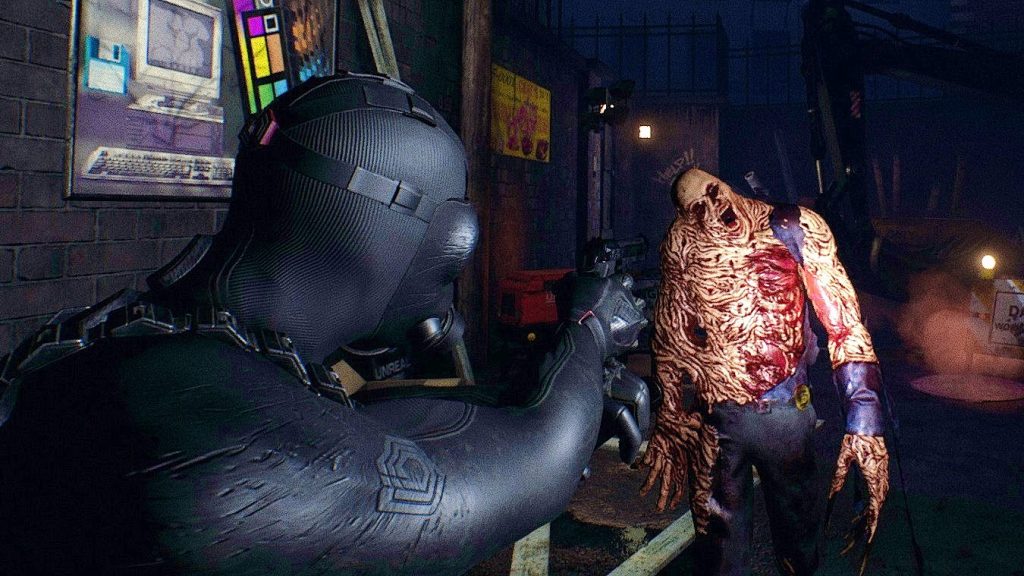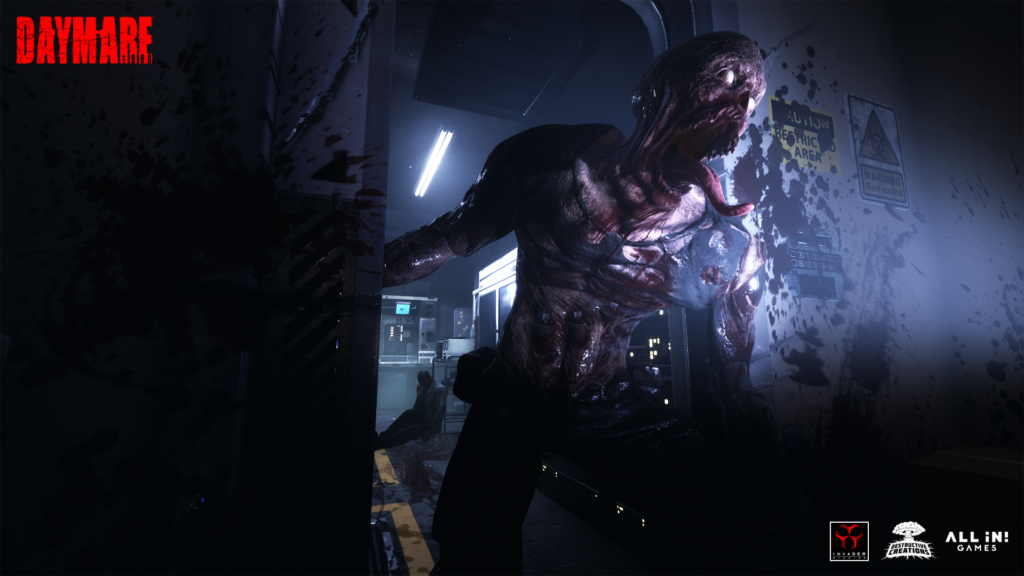
I wanted to like Daymare: 1998. I wanted to like it despite its utterly stupid title – what the heck is a Daymare? – and ridiculous subtitle. I wanted to like it despite the hideous character models, which look like shiny plastic dolls and are animated about as well. I wanted to like it despite its bad writing, terrible voice acting, numerous glitches, its confusion of difficulty with quality and its utter non-scares. But the truth is, despite how hard Invader Studios, a small team of about 10 people, obviously worked on it, that Daymare isn’t a very good game. Its reverence for classic survival horror games, especially Resident Evil, is obvious, but Daymare is so busy paying tribute to the games that came before that it forgets to be its own thing. Instead, it’s a poor imitation of better games.
Daymare starts in traditional survival horror fashion: an evil company is playing with contagions that don’t understand, and somehow, that contagion gets out, infecting everyone in the entire lab. You start the game as Agent Liev, a member of H.A.D.E.S. (no, I’m not joking, though I wish I were) Hexacore Advanced Division for Extraction and Search. Like more paramilitary organizations, H.A.D.E.S. has terrible people to go along with its awful acronym. Liev is probably the worst of them, a generic no-nonsense soldier with nothing interesting to distinguish him from the stereotype he embodies other than a bad attitude and edgy dialogue. After an interminable cutscene bursting with bad writing, a monstrous dump of exposition, and the pseudo-military speak you only hear in video games and bad films that take themselves far too seriously, you are dropped off at the location of the accident to recover samples of the virus that has leaked, as well as research samples that have been left behind. Crew expendable.
"In case you’re still not sure that you’re playing the bad guys, the first major things Liev does is shoot a wounded survivor in the head. “Orders are orders,” he remarks dryly."
In case you’re still not sure that you’re playing the bad guys, the first major things Liev does is shoot a wounded survivor in the head. “Orders are orders,” he remarks dryly. Shortly thereafter, you learn that the people inside the facility have been turned into zombies (because of course they have), and you start killing them and solving puzzles to unlock other areas of the facility. It’s all very rote and uninteresting, and I wouldn’t blame anyone for skipping as many of the cutscenes and collectibles as they could to get on with the gameplay.
To be fair, the gameplay is better than the presentation, and the game largely looks and sounds fine outside of the abysmal character models and voice acting. The gameplay is classic survival horror, and you’ll pick up ammo, health items, and important story items as you progress, having to manage your limited inventory and resources. The game does have some good ideas here. For instance, you’ll have to go into your inventory – accessed by a computer on Liev’s arm – and reload your extra magazines with ammo from your inventory before you can use them to reload your weapon.
Going into your inventory doesn’t pause the game, so you’ll have to do it when you’re sure nothing is going to attack you. You’ll also have to equip them to a quick access screen (where you can also equip healing items), allowing you to fill magazines with different types of ammo and chose which one you want at any given time. You can also choose between a slow and fast reload. The first deposits your old magazine into your inventory, but it takes a long time. The second throws the magazine on the ground, giving you a much faster reload, but removing the magazine from your inventory until you pick it up. The trade-off is interesting, and I often had to think about what I wanted to do at any given moment.
"The aiming controls were wonky, at least on a controller, which was how I played, and I didn’t feel like I had the control of my weapon that I wanted. "
Unfortunately, Daymare’s combat can’t capitalize on these ideas. The guns feel and sound suitably powerful, but combat simply doesn’t feel good. The aiming controls were wonky, at least on a controller, which was how I played, and I didn’t feel like I had the control of my weapon that I wanted. In a game where ammo is limited and death happens quickly, unresponsive controls are particularly annoying. The game’s enemies aren’t particularly interesting, either. The zombies are the standard “they’re-slow-until-they’re-not” type who have basically one attack: grab you and puke on you until you manage to mash yourself free. Then there are the heavily telegraphed enemies who initially appear in tanks and you accidentally free. They can take more damage, and deal more, etc. Nothing here is exciting and fresh, and Inavder’s idea of difficulty seems to be to make their enemies bullet sponges. Except, inexplicably, when they’re not and this headshot happens to pop their skull. There’s no rhyme or reason here, and these enemies just aren’t fun to fight.
Daymare attempts to break these combat sections up with puzzles, but they’re just as tedious, and often poorly explained. One of the more egregious examples requires you to enter the correct answers to riddles on a computer. You can find the answers by examining the paintings in the areas nearby. Simple, right? Except all the letters on the in-game keyboard have been replaced with Greek characters. So, not only do you have to remember the answers, you must look at a real keyboard as you enter them so you can translate them into the Greek characters. This isn’t clever or interesting; it’s merely tedious, and it requires you to go outside of the game to solve the puzzle. Another requires you to determine a combination lock by looking at a bookshelf and noting the volumes that aren’t there. Unfortunately, there is no clue as to what order the numbers go in, and you have to sit there inputting different combinations until you find the right one.
The environments aren’t much better. You do get out of the facility, and you do play other characters, like Sam, a man who suffers from hallucinations without his meds (which he is, conveniently, unable to take for a while). The others are just as badly written and voiced as Liev is, and their motivations are just as full of clichés. The other environments include a small town, the woods, several houses, back roads, a hospital, etc. All these places feel artificial. There are knocked down items in certain areas to prevent you from exploring, and the environments are incredibly linear. Resident Evil’s mansion this ain’t. Invader tries to vary things up with environmental humor, poking fun at or making reference to Half-Life 3, John Carpenter’s The Thing, Resident Evil, and several others. This wouldn’t be an issue if these jokes were funny, but they aren’t. Putting several typewriters in a game obviously inspired by Resident Evil isn’t funny or clever, especially when said game isn’t good.
"Daymare may love Resident Evil, but it certainly doesn’t understand why it worked the way it did, and for a game that proudly wears its 1998 subtitle, it seems to have forgotten why those games were designed the way they were."
The game also fails to do the whole limited resources part of survival horror properly, and this factors into the game’s save system. Near the end of the first level, I was low on health, out of healing items, and nearly out of bullets. There were no more healing items (I found a grand total of 3 in the entire level), and at the end I was expected to hold out while I was rushed by several zombies. I died several times, and considered loading an old save. Unfortunately, since Daymare uses an autosave system, the only thing I could have done was restart the level. I opted to run around in circles until the door opened, and I could escape. Resident Evil understood that a game with limited resources meant that going back to older times and trying the same things repeatedly would be necessary, because you’d run out of resources and potentially be stuck. That’s why the game has a manual save system and uses ink ribbons for the typewriter to keep players from abusing it. Daymare doesn’t. It may love Resident Evil, but it certainly doesn’t understand why it worked the way it did, and for a game that proudly wears its 1998 subtitle, it seems to have forgotten why those games were designed the way they were.
And then, of course, there are the bugs. I got sound in the first few cutscenes, but after that, it stopped working completely, only to return when gameplay resumed. It wasn’t terrible, because it saved me from the game’s dialogue, but it was annoying, especially considering how long Daymare’s cutscenes are (read: too long). One enemy, who got up after I shot him on a pair of steps, fell through the steps and was trapped in a part of the environment where he couldn’t hurt me. The result is that Daymare feels unfinished, and in a game that already doesn’t play well, that’s unacceptable.
Daymare desperately wants to be Resident Evil, but it just doesn’t have the design chops. The environments are boring, the enemies are generic, the aiming is faulty, the writing and performances are awful, the title doesn’t make sense (most of the game takes place at night), the experience is filled with bugs, and the game mistakes difficulty (limited resources) for design. It’s a game with very little about it to recommend and if I hadn’t had to play it for review, I would had stopped after about an hour in. It’s hard to be angry at Invader Studios for this; they’re a small team and this is their first game. I hope that it’s something they’ll be able to learn from. But Daymare is just another in a long line of examples that proves that a developer loving design from a certain era doesn’t mean that they understand it.
This game was reviewed on the PC.
Multiple characters to play with. Guns feel and sound good. Environments look good.
The writing is awful. The voice acting is really bad. The character models look terrible. The game confuses difficulty for quality. Aiming is wonky. Several bugs. Generic enemies and locations. Level design isn't interesting.



















